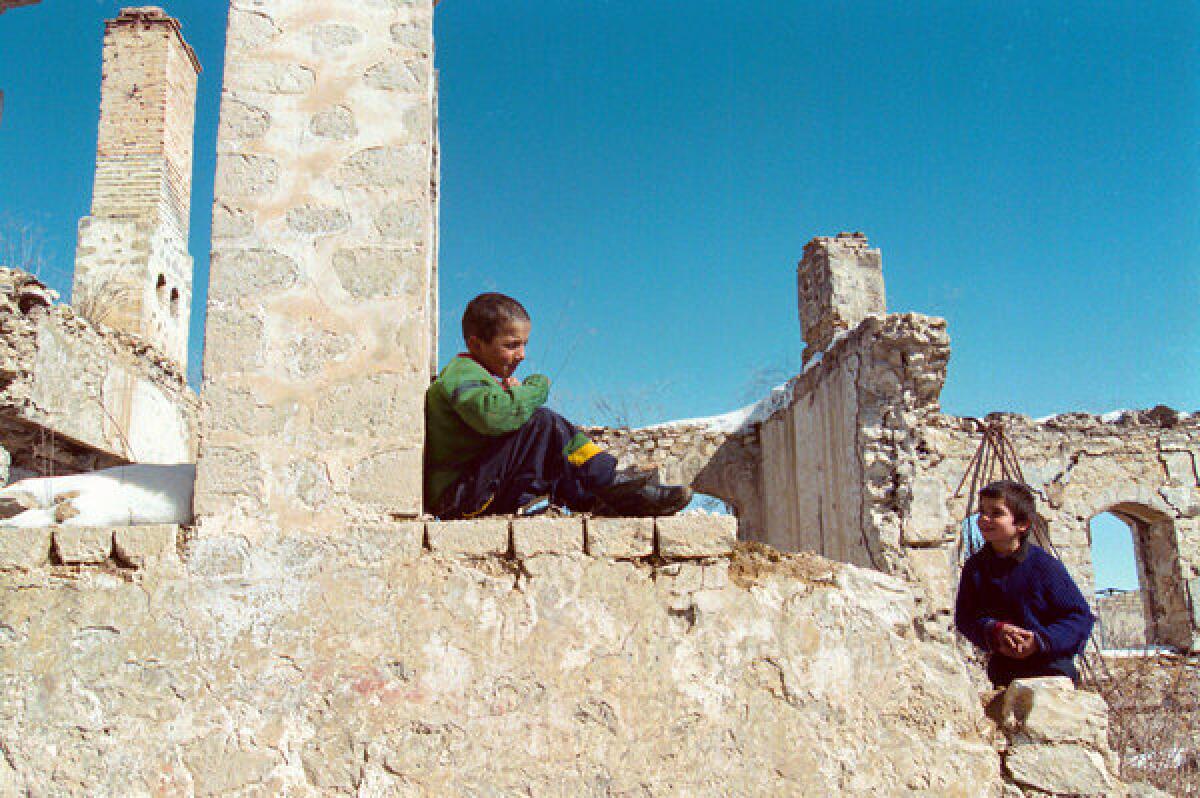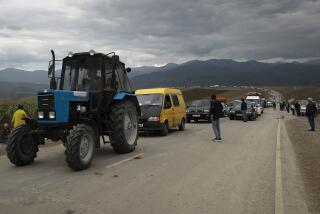Nagorno-Karabakh: Old conflict is neither gone nor forgotten

Sporadic sniper fire over sandbagged trenches that separate Armenians and Azerbaijanis across the disputed territory of Nagorno-Karabakh has been a routine feature of daily life throughout the 19 years that the two sides have grudgingly observed a cease-fire.
But the harassing potshots and provocative power plays have taken on a more ominous feel in recent weeks as pressure mounts on both sides of the “frozen conflict” for uncompromised victory in one of the world’s most bitter armed standoffs.
It was 25 years ago next month that seething hatred boiled over in Azerbaijan’s second-largest city, Sumgait, and majority Azeri nationalists slaughtered 31 Armenians in an outpouring of rage against their dominance in remote and strategically insignificant Nagorno-Karabakh.
The approaching anniversary, a coinciding presidential election in Armenia and the resettling of Armenian refugees from Syria in the disputed territory have stoked simmering resentment and spurred concern that another deadly clash may be on the horizon.
A 1991-94 war took an estimated 30,000 lives and displaced more than a million before the cease-fire was arranged. The United States, Russia and France agreed to oversee negotiations on a permanent resolution.
The problem, those familiar with the obscure but virulently emotional conflict explain, is that none of the parties is satisfied with the status quo of international recognition that the enclave is Azerbaijani territory but under Armenian control. Nor will either side make even symbolic concessions to break the nearly two-decade impasse.
A look at the map of the Caucasus region provides insight into the manipulations of Josef V. Stalin that nourished the roots of the conflict. Although Armenians had managed to stave off aggressive forays by the Persian, Ottoman and Russian empires for the better part of two millennia, their autonomous enclave was made part of the Azerbaijan Soviet Socialist Republic after the Bolsheviks consolidated control over the region in the early 1920s. Stalin served as commissar of nationalities before ascending to the Kremlin, and he executed a divide-and-conquer strategy to keep nationalism in check. The move also was meant as a gesture to Turkey, awarding the enclave to its Azeri allies instead of the Armenian targets of the 1915 genocide.
Ethnic resentment percolated under the lid of Communist repression until the 1980s, when reform-minded Soviet leader Mikhail S. Gorbachev opened Pandora’s box with his campaigns for perestroika and glasnost that encouraged confrontation of society’s ills, not sweeping them under the carpet.
Isolated, impoverished and far from the oil bonanza transforming eastern Azerbaijan, one might wonder why Nagorno-Karabakh is so fiercely coveted by either side.
“It’s a fantastically important trade route, not only for energy but for shipping and other issues,” Lawrence Sheets, the International Crisis Group’s director for the South Caucasus, said of the strategic territory where Europe and Asia meet. “Azerbaijan and Armenia have been in a state of war for more than 20 years. There’s a cease-fire, but if the conflict were to re-erupt on a larger scale, you’re talking about possibly a regional war that could drag in very important regional powers.”
U.S. oil companies have significant investments in Azerbaijan, as well as important emotional ties to Armenia, with as many Armenians living in the United States as in the ancestral homeland. Russia also needs peace to conduct its shipping and naval operations in the Caspian and Black Seas that flank the region. The expanding economic ties between Baku, the Azerbaijani capital, and Iran draw another influential iron into the fire. And Turkey, finally willing to talk of restoring ties with Armenia after a nearly century-long hiatus, insists that the Armenians give up the disputed enclave as a precondition.
While sober-minded observers see nothing to be gained by either Armenia or Azerbaijan from a rekindling of the conflict, that danger persists in the absence of a negotiated end to a dispute that has often bordered on the hysterical.
On Monday, Azerbaijani Foreign Ministry spokesman Elman Abdullayev accused Armenia of “an act of provocation” in settling Armenian refugees from the Syrian civil war in Nagorno-Karabakh in an attempt to “change the demographic situation in the region.”
Robert Avetisyan, permanent representative of Nagorno-Karabakh at the enclave’s diplomatic mission in Washington, denounced the claim as Azerbaijan’s attempt to politicize a humanitarian rescue of those fleeing bombardment of Syria’s main city, Aleppo, home to about 80,000 ethnic Armenians. Although thousands have turned to Armenia for aid, only about 30 families have been settled in Nagorno-Karabakh, Avetisyan said.
Added to the recent pressure rising in the enclave is a newly rebuilt airport near the capital, Stepanakert, that Avetisyan said would be put into operation soon, whether Azerbaijan backs down or not from threats to deny use of Azerbaijani airspace.
Despite the mutually disadvantageous standoffs and steady gusher of accusations, the stunted arbitration of the Organization for Security and Cooperation in Europe is about all that stands between the rivals and reignited fighting, said Olga Oliker, associate director of Rand Corp.’s International Security and Defense Policy Center.
“Nobody likes the status quo” of Armenian occupation of territory recognized as Azerbaijani, Oliker said. “But nobody can see any way to resolve it.”
ALSO:
Dozens killed in blasts at Syrian university
France to triple its forces in Mali, defense official says
Israeli soldiers kill Palestinian teen in West Bank confrontation
A foreign correspondent for 25 years, Carol J. Williams traveled to and reported from more than 80 countries in Europe, Asia, the Middle East and Latin America.
More to Read
Sign up for Essential California
The most important California stories and recommendations in your inbox every morning.
You may occasionally receive promotional content from the Los Angeles Times.











